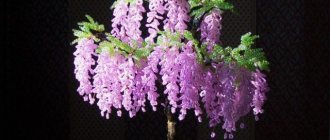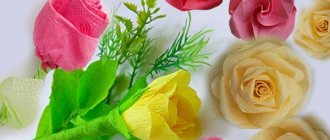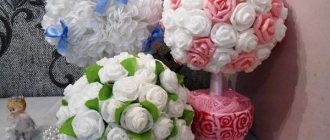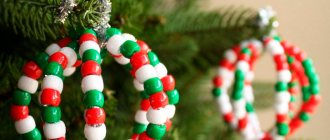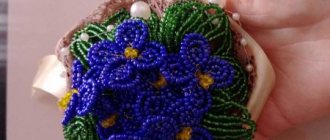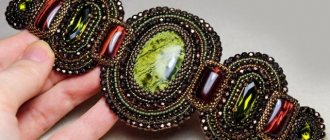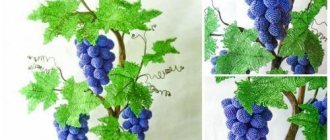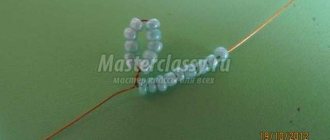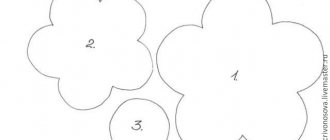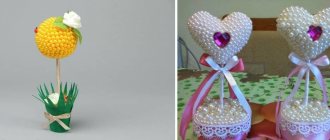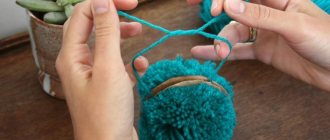Every self-respecting housewife strives to make her home more beautiful and maintain a cozy atmosphere in it. This can be achieved in different ways. For example, you can buy ready-made room decor items in a store, or you can do everything yourself.
In the recent past, it was fashionable to make your home more comfortable with the help of various crocheted napkins.
Now these decorations have changed a little.
The simplest and least expensive option would be a napkin.
And now you won’t surprise anyone by the fact that there are napkins in your house, but now they are made of beads.
Quite recently, crocheted openwork napkins have been in fashion. They decorated coffee tables, headboards of sofas and armchairs, and served as a stand for vases of flowers and hot teapots. But time passes, and fashion trends change along with it. So the openwork knitted napkin turned into a beautiful napkin with beads, and there is nothing surprising about it.
The weaving patterns of such napkins are similar to those of previous napkins.
In this article you will learn how to make a napkin from beads.
They are now much easier to make and have advantages.
It does not need to be washed, as dust does not form on it.
Advantages of a beaded napkin
Beaded napkins have a number of advantages over knitted tablecloths.
The methods of weaving such products are as simple as possible; even a novice craftsman can handle them.
- This napkin does not require periodic washing. After all, it is very difficult, in fact it is very difficult to get it dirty. And if this does happen, then just wipe the stain with a damp cloth and the napkin will be like new!
- The manufacturing principle of this product is as simple as possible. You can even do the work with your child, brother or sister.
- The attractive appearance of a beaded napkin, which cannot be compared with a lace knitted napkin.
- Cheap materials.
It looks so impressive that it cannot be compared with any knitted napkins.
It will cost you much less, because beads are affordable to everyone.
Necessary materials
- Beads of various colors and shades.
- A special needle with a thin eye for beading.
- A fishing line or thread to match the color of the beads (you can also use transparent, stretchy monofilament).
The threads must be white and strong to support all the beads.
Important! For beading it is better to use Czech beads, because... The beads in it are perfectly sized. If you take low-quality, crooked beads, you risk ruining the appearance of the product.
Mostly napkins are white, or with the addition of a few other colors.
Beads in hand
What you need to prepare to weave a napkin:
- White beads;
- Blue beads;
- Golden colored beads;
- Durable silk thread for weaving with beads or fishing line;
- And of course a needle.
The threads must be white and strong to support all the beads. Mostly napkins come in white, or with the addition of a few other colors, since white is a universal color and goes with everything.
It often happens that the patterns for making napkins are simple. As in this case, and in many others.
Related article: How to sew felt tulips
The principles of weaving are taken from crocheted doilies. Start weaving from the middle and continue weaving to the edge. In this case, it is possible to determine for yourself what size your napkin will be, gradually increasing the number of beads in the arcs. Literally this means that you can weave until you get tired of it or until you run out of beads.
Let `s start? Prepare a needle and thread eight blue beads onto it. Thread a needle through the first three beads to create a triangle.
String three more blue beads and thread them through one bead from where the thread came out. A small arc has emerged, make three more similar arcs so that the middle takes the shape of a rhombus.
The next row should also consist of 4 arcs, but the arc already consists not of three, but of five beads: 2 white, the middle is blue, the edge of two is white. You need to pull the needle through the bead, which protrudes more from the figure. The result will be a small flower.
Pass the needle through two white beads so that it comes out in front of the blue one. Third row: above the blue beads, make arcs of three white beads, and insert the needle into the white bead next to the blue one. And after that, you need to string five white beads and attach them by threading a needle through a white bead located in front of a blue bead. Then again an arc of 3 white beads.
The result is a star with white rays and a blue center. If you make it from wire, then you can stop the weaving at this point, and you will get a beautiful snowflake for the window. But no need to be distracted, continue weaving a napkin. Further, the number of beads in the row becomes larger, this accordingly affects the size of the product.
Related article: DIY foil embossing master class step by step for children
Pass the needle through two beads so that it comes out at the top of the beam. Next, string 7 beads, the middle one will be blue, and the outer ones will be white. Continue this way until the row ends.
After the row ends, you need to thread the needle through three white beads so that the needle again comes out in front of the blue one. And then put three white beads on the thread, and you will end up with an arc over a blue bead.
Then put on five beads again: in the middle there is blue, the outer ones are white, bring the thread in front of the blue bead and so on until the end of the row. Get 16 blue and white rays.
Then weave a row exclusively with blue beads, threading a thread through the top of the beam, and on a thread there are five blue beads.
The row that follows will be more varied, add gold beads. This is the sequence: 2 heads, 1 white, one gold, white, and two blue. Be sure to continue making this arc plan until the end of the row.
In this row, the arc also consists of 7 beads, only the order of stringing is different: white, two heads, white, two heads, white...
The next row consists of arcs of nine beads: 2 golden, 2 white, one gold, 2 white, 2 golden.
In the next row, weave an arc between the first and last white beads, and they consist of 5 goals. beads Simply push the needle through the remaining beads.
The next arcs will be woven from 3 goals, 2 whites, then thread a needle in a gold bead, then 2 whites, 3 goals, then 2 goals, 1 white, gold, white, 2 goals, and until the row ends .
You can see how to weave napkins from beads with your own hands using the diagrams and videos attached below.
Master class on weaving napkins from beads for beginners
The process of creating openwork beaded napkins with weaving patterns will be discussed in detail and step by step in this section.
The principles of weaving are taken from crocheted doilies.
The simplest technique for weaving such a product is to weave rings of beads that will make up the napkin.
Start weaving from the middle and continue weaving to the edge.
Start weaving the napkin from the center to the edges. First, form the base of the product, consisting of six rings that need to be closed into a common large ring.
In this case, you can determine for yourself what size your napkin will be.
Make a new row of beads of a different color. Increase the number of rings with each subsequent row.
You can weave until you get tired of it or until you run out of beads.
When you have weaved a napkin of the desired size, tie the thread and cut off the excess.
You can see how to weave napkins from beads with your own hands using the diagrams.
Important! Each ring should consist of the same number of beads.
Napkin “Swirls”
The “Swirl” bead napkin is woven into separate elements, which are finally joined to each other. To make it you will need: 2 shades of beads (for example, blue and yellow) and fishing line.
Step-by-step instruction:
- 12 beads are collected (2C, 2F, 2C, 2F) and closed into a ring.
- Then the next chain is typed according to the color. If the 1st row ends in a blue shade, then yellow is typed and vice versa. Row 2 includes three beads on each arc, for a total of six stripes. The line should be threaded, passing one piece of glass.
- The third chain is formed from five beads and six arcs according to the same pattern, threaded through the top.
- The fourth chain is formed from 6 glass balls, also 6 times in accordance with the color.
- The fifth row includes 5 beads of the same color and 12 arcs.
- The sixth row is formed in the same way as the fifth, securing each arc on top of the previous one.
- The seventh row consists of seven beads 12 times each. This completes one element.
- You need to make 7-9 similar elements.
- Before you start connecting them, you should see if all the swirls are directed in the same direction.
- Then fold the composition and combine all the blanks into a single napkin.
Napkins made of beads look beautiful on any holiday tables; they can also be placed under different vases. Previously, similar napkin products were even placed on televisions. They perfectly complement the comfort of the apartment and show the “taste” of the hostess.
https://youtu.be/5anDvRerE8khttps://youtu.be/L03r1KhVAVk
_
Examples of diagrams for creativity with descriptions
Note! Patterns for weaving openwork napkins are very similar to patterns for crocheting tablecloths, so if necessary, they can replace each other, you just need to show a little imagination!
In order to weave a beautiful napkin with beads, it is preferable to use calibrated beads so that it looks attractive.
For amateur needlewomen who are no strangers to holding beads in their hands and know how to use complex patterns, it will not be at all difficult to make a napkin consisting of spiral flowers.
The most popular weaving techniques are mesh stringing, cross stringing and mosaic.
The main thing when making a napkin from beads is to adhere to the weaving pattern and color sequence. We first weave the flowers separately, and then fasten them together with thread.
Each of these techniques has its own subcategories; they can, of course, mix with each other and change a little.
But here is a simpler pattern - such a funny web of beads.
Beads with sharp edges must be strung on a strong and thin thread.
If desired, you can also make them using thin wire and hang them as miniature snowflakes on the Christmas tree.
But here is a diagram that is quite difficult for a beginner to understand. But if you are an advanced craftswoman, then it will not be difficult for you to make a beaded napkin according to this pattern.
This fascinating activity is bead weaving.
If you couldn’t figure out the previous diagram, then here is its simplified analogue. First, individual flowers are woven, and then joined together with a thread and a needle.
A beaded napkin is a spectacular way to decorate your interior, either just for mood or in honor of the holiday.
Note! If the center of the weave lies crookedly, then it is worth passing the second row of thread through it, perhaps several times.
There aren't many ways to create them.
Beaded napkins: complex weaving patterns for beautiful openwork scarves step by step
Every self-respecting housewife strives to make her home more beautiful and maintain a cozy atmosphere in it. This can be achieved in different ways. For example, you can buy ready-made room decor items in a store, or you can do everything yourself.
In the recent past, it was fashionable to make your home more comfortable with the help of various crocheted napkins.
Now these decorations have changed a little.
The simplest and least expensive option would be a napkin.
And now you won’t surprise anyone by the fact that there are napkins in your house, but now they are made of beads.
Quite recently, crocheted openwork napkins have been in fashion. They decorated coffee tables, headboards of sofas and armchairs, and served as a stand for vases of flowers and hot teapots. But time passes, and fashion trends change along with it. So the openwork knitted napkin turned into a beautiful napkin with beads, and there is nothing surprising about it.
The weaving patterns of such napkins are similar to those of previous napkins.
In this article you will learn how to make a napkin from beads.
They are now much easier to make and have advantages.
It does not need to be washed, as dust does not form on it.
Advantages of a beaded napkin
Beaded napkins have a number of advantages over knitted tablecloths.
The methods of weaving such products are as simple as possible; even a novice craftsman can handle them.
- This napkin does not require periodic washing. After all, it is very difficult, in fact it is very difficult to get it dirty. And if this does happen, then just wipe the stain with a damp cloth and the napkin will be like new!
- The manufacturing principle of this product is as simple as possible. You can even do the work with your child, brother or sister.
- The attractive appearance of a beaded napkin, which cannot be compared with a lace knitted napkin.
- Cheap materials.
It looks so impressive that it cannot be compared with any knitted napkins.
It will cost you much less, because beads are affordable to everyone.
Necessary materials
- Beads of various colors and shades.
- A special needle with a thin eye for beading.
- A fishing line or thread to match the color of the beads (you can also use transparent, stretchy monofilament).
The threads must be white and strong to support all the beads.
Important! For beading it is better to use Czech beads, because... The beads in it are perfectly sized. If you take low-quality, crooked beads, you risk ruining the appearance of the product.
Mostly napkins are white, or with the addition of a few other colors.
Master class on weaving napkins from beads for beginners
The process of creating openwork beaded napkins with weaving patterns will be discussed in detail and step by step in this section.
The principles of weaving are taken from crocheted doilies.
The simplest technique for weaving such a product is to weave rings of beads that will make up the napkin.
Start weaving from the middle and continue weaving to the edge.
Start weaving the napkin from the center to the edges. First, form the base of the product, consisting of six rings that need to be closed into a common large ring.
In this case, you can determine for yourself what size your napkin will be.
Make a new row of beads of a different color. Increase the number of rings with each subsequent row.
You can weave until you get tired of it or until you run out of beads.
When you have weaved a napkin of the desired size, tie the thread and cut off the excess.
You can see how to weave napkins from beads with your own hands using the diagrams.
Important! Each ring should consist of the same number of beads.
Examples of diagrams for creativity with descriptions
Note! Patterns for weaving openwork napkins are very similar to patterns for crocheting tablecloths, so if necessary, they can replace each other, you just need to show a little imagination!
In order to weave a beautiful napkin with beads, it is preferable to use calibrated beads so that it looks attractive.
For amateur needlewomen who are no strangers to holding beads in their hands and know how to use complex patterns, it will not be at all difficult to make a napkin consisting of spiral flowers.
The most popular weaving techniques are mesh stringing, cross stringing and mosaic.
The main thing when making a napkin from beads is to adhere to the weaving pattern and color sequence. We first weave the flowers separately, and then fasten them together with thread.
Each of these techniques has its own subcategories; they can, of course, mix with each other and change a little.
But here is a simpler pattern - such a funny web of beads.
Beads with sharp edges must be strung on a strong and thin thread.
If desired, you can also make them using thin wire and hang them as miniature snowflakes on the Christmas tree.
But here is a diagram that is quite difficult for a beginner to understand. But if you are an advanced craftswoman, then it will not be difficult for you to make a beaded napkin according to this pattern.
This fascinating activity is bead weaving.
If you couldn’t figure out the previous diagram, then here is its simplified analogue. First, individual flowers are woven, and then joined together with a thread and a needle.
A beaded napkin is a spectacular way to decorate your interior, either just for mood or in honor of the holiday.
Note! If the center of the weave lies crookedly, then it is worth passing the second row of thread through it, perhaps several times.
There aren't many ways to create them.
Conclusion
Let's summarize. Weaving openwork napkins is not the most difficult task. If you thoroughly understand the schemes and select suitable, high-quality materials, then the work will bring only joy and benefit. After all, beading is not only an interesting and exciting activity, it helps develop fine motor skills in children and strengthens memory in adults!
Beads are a material from which you can weave anything.
VIDEO: Simple napkin made of beads - master class
50 original options for beaded napkins:
We recommend articles on the topic
How to decorate holiday candles for a wedding?
A wedding is a very special holiday. Accessories help to emphasize his sincerity and at the same time solemnity. Candles not only have a decorative function, they are necessary during wedding ceremonies...
Making an educational crawling mat with your own hands
Parents set a goal to comprehensively develop their baby, starting from birth. A crawling mat can help with this. You can purchase the device at a children's store. But much more interesting...
Cleaning up the closet
Many people strive to maintain order and cleanliness in their own home. To achieve this, all premises are cleaned regularly. And there is often no time left to organize the closet. Especially relevant for large…
Fastenings for shelves in the closet. What are they and why are they needed?
The main part of each cabinet is the shelves, thanks to which compact storage of various items is organized. A long and high-quality service life directly depends on the reliability and correctness of fastening...
